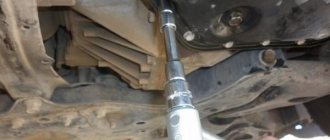Specifications Reviews
The second generation Toyota RAV4 XA20 appeared in 2000 - after the completion of production of the first generation. The car has become more popular than its predecessor and Toyota fans still love this crossover and actively purchase it on the secondary market. The car was produced until 2006, replaced by the third generation.
We have collected as much information as possible about the car and its malfunctions so that you know what you may encounter and choose the right model when purchasing.
Body
The crossover has become more attractive and modern in appearance. Two types of body were also produced - 3-door and 5-door. The 5-door body was more popular due to its extended base, more space in the cabin and driving performance.
Large lights appeared in front, a huge bumper with large fog lights. On the side, a painted plastic trim nicely complements the look by widening the arches. At the rear, everything is much simpler - large lights, an interestingly shaped bumper and a spare wheel on the trunk lid, which is better to move into the trunk so that the door does not gradually sag.
Restyling received only other bumpers, distinguished at the front by round, recessed PTFs.
There are no problems with rust on the Toyota RAV4 2, although Moscow cars are already rusting, plus age is taking its toll. In other regions, if the car is not pulled out after an accident, corrosion does not become active. Among the body problems, the headlights gradually turn yellow, the washer motor often fails, and the door electronics, including the locks, stop working. The last problem is caused by a break in the wiring in the corrugations or failure of the resistor.
These are minor problems that can be solved inexpensively, fortunately they appear rarely.
Dimensions of a 5-door car:
- length – 4245 mm;
- width – 1785 mm;
- height – 1680 mm;
- wheelbase – 2490 mm;
- ground clearance - 200 mm.
The 3-door version is shorter by 395 mm, although the wheelbase is reduced by only 210 mm. The height is 10 mm less.
Restyling
In the period from 2004 to 2005, restyled RAV 4 models were produced. Their cost differs significantly from pre-restyling cars. Externally, the RAV 4 has remained virtually unchanged, except for the optics and voluminous bumpers. The automatic transmission has been improved, because in pre-restyling models, an error was often caught, which affected the operation of the automatic transmission and over time led to automatic transmission failure. More airbags have been installed. The car was equipped with ESP, EBD. Radio control buttons appeared on the steering wheel.
If the package does not include cruise control, then it can be installed much cheaper in the restyled model thanks to the electronic gas pedal.
Toyota RAV4 interior
Interior
There is no luxury in the interior, Toyota is an ordinary company, so they did everything in their own style - simple materials coupled with excellent assembly. There is the usual plastic, fabric covering of seats and door panels, although velor is sometimes found. Velor is rare, but after purchasing such a car it is better to dry clean it, because it actively absorbs odors. In restyling, leatherette appears.
There is not much free space, as can be seen from the size. Regular seats with mechanical adjustments and heating function. In the back of the RAV4 there is a sofa for 3 people, although in the 3-door version it is uncomfortable for three to sit, and it is not designed for five passengers.
The driver gets a 3-spoke multi-steering wheel with buttons for music. Behind the wheel is an analogue instrument panel, separated by three wells. The left one is equipped with a speedometer, the central one is equipped with a small tachometer, and the right one is equipped with a fuel level sensor, engine temperature and automatic transmission mode.
The center console is simple but still looks nice. The standard cassette player upstairs is frustrating, but changing it is not a problem. Below are the classic climate control knobs with separate buttons for heat recovery and air conditioning. The buttons are inserted flush with the panel - beautiful. Below we inserted a cigarette lighter, an ashtray and buttons for turning on the heated seats.
The tunnel is equipped with two large cup holders, a gearshift lever and a mechanical handbrake. There is a large niche in front of the armrest for small items.
Interior problems often include leaking water due to a clogged Toyota RAV4 XA20 air conditioner drain or sunroof. It is advisable to quickly correct the situation so that the seat fastenings do not rust.
The trunk is small, the volume seems to be 400 liters, but it is short in length. The rear sofa does not fold flat, but the seats can be removed. The volume with the sofa folded is 1150 liters. In a 3-door car the situation is even worse - 150/766 liters.
Engines
| Type | Volume | Power | Torque | Overclocking | Maximum speed | Number of cylinders |
| Petrol | 1.8 l | 125 hp | 161 H*m | 12.2 sec. | 175 km/h | 4 |
| Petrol | 2.0 l | 150 hp | 192 H*m | 10.6 sec. | 185 km/h | 4 |
| Petrol | 2.4 l | 161 hp | 224 H*m | — | — | 4 |
| Diesel | 2.0 l | 116 hp | 250 H*m | 12.1 sec. | 170 km/h | 4 |
Read more
The range of motors is small, as can be seen from the table above. Mostly common on the market are 2-liter gasoline engines 1AZ-FE and FSE with a timing chain drive. The chain is durable, runs 200-250 thousand kilometers. Closer to 300 thousand, the engine requires capital due to wear of the piston group.
The engine is demanding on the quality of the oil, otherwise carbon deposits will appear and the oil channels will become clogged, which leads to engine wedge. Afterwards, the bolts may pull out of the block, causing oil and antifreeze to leak. After 200 thousand kilometers, the VVT variable valve timing system needs to be replaced, as evidenced by the “Check” on the dashboard. When checking, increased fuel consumption, weak traction and floating speed indicate a VVT malfunction.
Service life of other systems:
- throttle cleaning - every 80,000 km;
- cooling system pump – 100,000-150,000 km;
- radiator - 150,000-200,000 km;
- catalyst - 200,000-250,000 km;
- ignition coils - 150,000-200,000 km.
The diesel engine of the second Toyota RAV4 D-4D causes almost no problems up to 200 thousand kilometers. Afterwards, classic diesel problems will begin - injectors, cleaning the VRV vacuum valve, EGR valve, etc. A diesel chain drive lasts approximately the same 200 thousand kilometers.
Toyota RAV4 II generation XA20 (2000-2005)
The popularity of the second generation RAV-4 during the years of its release was very high. And with the advent of a new generation of the model, these cars do not stagnate on the market. Why are they attractive?
History 06.94 Presented 3-door station wagon Toyota RAV-4 I generation Toyota RAV-4 II generation since 2000 Toyota RAV-4 III generation CA30 (2006-2013)
BODY
Compared to its predecessor, the list of modifications of the second generation Toyota RAV-4 was reduced - the creators abandoned the production of unpopular convertibles and limited themselves to 3- and 5-door station wagons. 4 years after the start of production, the model was slightly updated.
All RAV-4s have a monocoque body, which is protected from corrosion by galvanization. By the way, when buying a used car, you should take into account that it could have been in traffic accidents. These are operating costs in large cities. If the repair is carried out poorly, rust will appear on the body over time.
The majority of RAV-4s are officially sold five-doors. These Toyotas were delivered to us with only one type of engine - 2.0 liters and permanent all-wheel drive. The rest of the gasoline and diesel modifications were imported by gray dealers, and the 1.8-liter “Ravchiki” were single-wheel drive.
The five-door RAV-4 with a spacious interior and a capacious trunk is perfect for the role of a family vehicle, but the “three-door” with a 290 mm shorter wheelbase is a car for selfish people: its interior is designed for four. Moreover, thanks to the rear seats that slide forward/backward by 15 cm (this option is provided in both versions), two passengers can sit in the “gallery” of the 3-door version quite comfortably, but the trunk will be purely symbolic (175 liters in total). A wide range of longitudinal adjustment of the front seats and the presence of steering column height adjustment in both versions allows even tall people to sit comfortably in the driver's seat. Getting into the car is not difficult. Forward visibility is good, but rear visibility is limited by large headrests.
Even the basic versions of the RAV-4, which were officially imported, are richly equipped: central locking, power steering, electric windows and exterior mirrors, fog lights, air conditioning, branded radio, front airbags, ABS, EBD (axle brake force distribution) systems. .
Among the shortcomings, we note: not very high quality of sound insulation (at high speeds, the sound of the engine confidently penetrates into the cabin), as well as the luggage compartment shelf that often “grumbles” when driving over uneven surfaces. By the way, it can be installed at two different levels, and such castling eliminates the squeaking problem for a while.
ENGINE
Most "ravchiki" are equipped with 2.0-liter gasoline engines. Cars with a 2.4-liter gasoline engine and a 2.0-liter turbodiesel are rare, but versions with a 1.8-liter gasoline engine are almost impossible to find.
If the odometer reading of a used car is close to the 100 thousand km mark, be prepared to spend money on expensive maintenance. For reliable and durable operation, the timing drive uses a metal chain. The designers also abandoned the use of hydraulic compensators. The thermal clearances of the valves will have to be adjusted once every 100 thousand km (at a branded service station, one adjusting washer costs from $7.5 to $9.5, and labor costs about $65). But in a turbodiesel with a Common Rail system, with a mileage of 100 thousand km, you will have to spend even more. Its timing belt uses a belt that needs to be replaced along with the tension and guide rollers and another tensioner (branded spare parts will cost about $350 and labor - $75). It is also necessary to check the condition of the water pump, which is also driven by the timing belt.
All gasoline engines are equipped with Toyota's VVT-I variable valve timing system, which optimizes their operation at different speeds, and an ignition system with individual coils for each spark plug. According to motorists, all these systems do not create problems.
Gasoline units are sensitive to fuel quality, which affects dynamics and idling. Bad fuel also quickly “kills” expensive (1 piece - about $26) spark plugs with platinum electrode tips. Moreover, the service workers noted that the use of ordinary candles is not provided. If the fuel filter is not replaced correctly, the sealing rings may be installed incorrectly, as a result of which, due to air leaks, the engine starts the second/third time and does not develop full power.
It is recommended to check the condition of the multi-ribbed attachment drive belt every 40 thousand km and replace it if necessary. But there were cases of its breakage at 60 thousand km.
TRANSMISSION
Most RAV-4s were equipped with 4-speed automatic transmissions (about 80% of cars sold). Sometimes there were problems with the automatic control unit. They were solved by reflashing the “brain” or replacing it (about $900). The malfunction manifested itself as a violation of gear shift modes. But there are no serious complaints about the 5-speed manual transmission and hydraulic clutch drive. A “sore” characteristic of both types of gearboxes is that the left axle shaft seal loses its seal over time (spare part – $16, labor – $50).
Transmission maintenance is expensive. You have to fork out money every 40 thousand kilometers when it is necessary to change the oil in the gearbox, transfer case and rear gearbox. At a branded service station for owners of versions with an automatic transmission, this will cost about $200.
Unlike many other SUVs, the RAV-4 is equipped with permanent all-wheel drive. The transmission is equipped with a center differential locked by an electronically controlled clutch. Under normal driving conditions, torque is distributed among the axles in a ratio of 50:50, and if one of them slips, the traction goes to the wheels with the best coefficient of adhesion. There are no low gears or inter-wheel locks in the Ravchik. True, a self-locking differential in the rear gearbox was, in principle, provided, but such versions were not officially supplied to us. By the way, the suspension travel is small, so the diagonal suspension of the wheels occurs quite early. The all-terrain arsenal of the RAV-4 and a ground clearance of 200 mm allow this car to move quite confidently on a snowy or wet road, overcome small sections of a muddy country road, or drive up to the water along the sandy shore of a lake or river. But for more serious off-road rides, the “Ravchik” is not suitable.
SUSPENSION
The independent front and multi-link rear suspensions of the RAV-4 are configured in accordance with the “parquet” orientation of the car - moderately rigid, which allows you to drive quite actively without serious rolls, but when driving over large bumps they easily “break through”.
After 40 thousand km, when driving on bad roads, you will have to change the bushings of the front and rear anti-roll bars, but their struts can last over 100 thousand km. All other suspension parts take even longer to take care of – 150–200 thousand km. Moreover, service workers claim that more often the “rubber bands” of the front control arms are changed due to age-related wear and tear - they crack. In this case, you will have to spend money - in the original, silent blocks are supplied together with levers, but “ball” ones are offered separately.
In the rear suspension, silent blocks are usually replaced due to the fact that the eccentric bushings in them are tightly “grabbed” by rust, which does not allow wheel alignment to be adjusted. In this case, you have to use a grinder to cut off the rusted bolts and change the longitudinal rod, in the silent block of which the bushing is installed. But the silent block of the lower arm, in which the eccentric is also installed, is supplied separately. To avoid these problems, experts recommend visiting a service center every 40 thousand km to check the wheel camber and lubricate the adjustment mechanisms. Replacing the rear bearings is also expensive - they are supplied with the hub. The good news is that the bearings last a long time.
STEERING
The steering, equipped with a hydraulic booster, is durable: the tips and tie rods can last about 200 and 100 thousand km, respectively. The most typical problem with the braking system is that over time, the parking brake drive mechanism in the rear drums becomes jammed. Therefore, experts advise servicing this unit every 40 thousand km by lubricating it.
RESULT
So, let's summarize. The second generation Toyota RAV-4 is highly reliable, and the service life of many components and assemblies is not exhausted even on cars of the first years of production. Moreover, judging by the operating experience of the first generation of the model, RAV-4 owners rarely have to spend money on repairing failed parts. Servicing this SUV is more expensive than many Toyota passenger models, but cheaper than other all-terrain vehicles.
Thanks to its compact size (compared to large SUVs) and good handling, the RAV-4 feels great on city streets, and its 200 mm ground clearance makes it easy to climb city curbs when parking or avoiding traffic jams.
Permanent all-wheel drive provides good stability on slippery and wet roads, as well as moderate cross-country ability off asphalt roads.
Japanese transmission
The engines were paired with either a 5-speed manual or a 4-speed automatic. Front-wheel drive or all-wheel drive; all-wheel drive cars were the most popular. It’s better to go with a mechanic, because the only faults it has are clutch wear and input shaft bearing noise at 200 thousand.
Until 2003, the machine had a poorly designed cooling system, which caused chips to burn out and shocks to appear. It’s better to solve this problem quickly, since it will cost only 5,000 rubles. At 300 thousand, a rumble of the first gear appears and the positions of the satellite axes are broken. The problem is not solved, the box must either be changed or driven until it dies completely.
The transmission is tenacious; at most, there is a howl of the outboard cardan bearing and play in the crosspieces. Everything is resolved quickly and cheaply.
Suspension and steering
The crossover is built on the Toyota Corolla platform; it has MacPherson struts on the front axle and trailing arms at the rear. Anti-roll bars are installed all around. The bushings of the front stabilizers of the RAV4 XA20 need to be changed every 70,000 km, and after a maximum of 30 thousand, the struts themselves. Rear stabilizers serve for 150,000 km.
The shock absorbers are weak, so they require replacement every 150 thousand kilometers; at the same time, the front support bearing, ball joints and wheel bearings need to be replaced. After another 50 thousand, the levers need to be replaced. All the parts are cheap, even overhauling the entire chassis is relatively inexpensive - 50 thousand rubles.
Steering is rack and pinion with hydraulic booster. The silent blocks of the rack last for 100 thousand, then they start knocking. Sometimes the rack leaks; replacement will cost 30,000 rubles.
After replacing the brake pads, the pedal falls out. It seems that something is going wrong, but after a few days everything corrects itself.
Advantages and disadvantages
The downside of the second generation Toyota crossover is the quality of the interior materials. The hard plastic wears out quickly and is easily scratched; numerous “crickets” are the norm for Rav 4 2nd generation. There is also a lack of sound insulation: you can clearly hear the engine, the suspension and pebbles in the arches. Another disadvantage is that the trunk is not large.
Rav 4 20 with three doors rear view
There were also questions about the reliability of the Toyota SUV. Most often, the steering rack fails without driving even 70 thousand km. 2nd generation Rafik engines often consume oil.
Problems also include the demanding nature of engines regarding fuel quality; power units with direct injection require good gasoline. If you use bad gasoline, the high pressure fuel pump may break.
Among the advantages, we note permanent all-wheel drive, reliable passability, but negatively affecting the consumption of Toyota Rav 4 2nd generation. Another advantage is liquidity on the secondary market; an SUV in good condition can surprise buyers with its price.
Price
There are many crossovers on the market, which owners sell for an average of 500,000 rubles . For this money, the car will be in good condition and is unlikely to require intervention at first. The cost of service is also low.
When purchasing, the main attention should be paid to the suspension, because at a certain mileage it develops too many problems at the same time. Keep an eye on the car for mechanics so that the Toyota RAV4 XA20 will serve you as long as possible. Otherwise, the car is quite reliable - Japanese quality.
Heated seats
When choosing a RAV 4, you need to pay attention to uniform seat heating, because... This is their common problem. Restoring and repairing all heating elements is expensive.
In addition to the above tips, a potential Toyota RAV 4 owner needs to learn general tips for choosing used cars.
In technical terms, the manufacturers of the RAV 4 have improved it significantly.
In technical terms, the manufacturers of the RAV 4 have improved it significantly.










